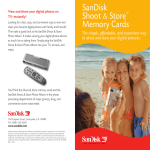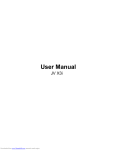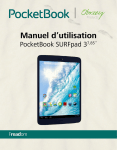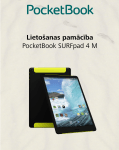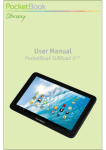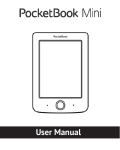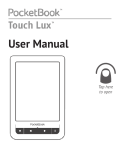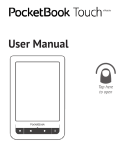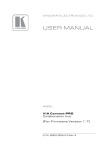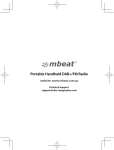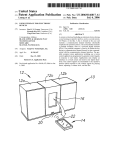Download User Manual PocketBook SURFpad 3 (8)
Transcript
User Manual 7,85’’ PocketBook SURFpad 3 Contents SAFETY PRECAUTIONS 5 Storage, Carriage and Usage Conditions 5 Maintenance6 RF Safety 6 Utilization7 APPEARANCE8 TECHNICAL SPECIFICATIONS 9 GETTING STARTED 10 Charging The Battery 10 Unlock Your Device 11 Home Screen 11 Display Views 12 Finger Gestures 13 Extended Home Screen 13 Using the On-screen Keyboard 14 Menus15 Establishing Wi-Fi 15 Inserting Micro SD Card 16 Mobile Networks Connection 16 SOFTWARE18 Manage Data Application Launching Creating Folders on the Home Screen Application Removing List of Opened Applications Preinstalled Applications PBI Packages Support Listen to the Music 2 18 19 20 21 21 23 24 25 CONTENTS Music Library 25 Gallery26 MX Player 26 Camera27 Photo and Video Modes 27 Browser27 Email28 Setting Up the Account 28 Inbox28 SETTINGS29 Language & Input 31 Sound Settings 32 Display Settings 33 Storage34 Connecting Devices to Your Tablet 34 Unmounting External Memory and Devices 34 Location Access and Security 35 Date & Time 35 Restore Your Tablet to Factory Settings 36 Battery Charge State 37 Wi-Fi Connection 38 Connecting to Wi-Fi Network with Automatically Obtained IP-address Connection to Wi-Fi Network with Manual Configuring Network Settings 38 39 Advanced Options 40 Turn off Wi-Fi 40 Bluetooth40 Transferring Data 41 Information about Apps 41 3 CONTENTS FIRMWARE UPDATE 43 Automatic Update 43 Manual Update 44 Troubleshooting45 CUSTOMER SUPPORT 46 COMPLIANCE WITH INTERNATIONAL STANDARDS 47 4 Safety Precautions Before start working with the Device, please, read this section carefully. Following these instructions will help you ensure your safety and extend service life of the Device. Storage, Carriage and Usage Conditions Device operating temperature range is 0°C to +40°C, so don’t expose the Device to excessively high or low temperatures. Never leave cables near heat sources. Heated cables or their insulation may become deformed or damaged, which could lead to fire or electric shock. Try to avoid next impacts: •direct sunlight •direct flame or smoke (cigarette, lighter, open fire etc.) •exposure to liquids or damp (do not use the Device in the rain, in the street at higher humidity, near bodies of water etc.) •penetration of liquids or moisture •exposure to strong electromagnetic fields, electrostatic charges and artificial sources of UV electromagnetic radiation •excessive mechanical pressure on the screen, connectors and keys of the Device. Do not leave the Device for a long time in poorly ventilated environment, e.g. in a car or in closed tight boxes/packaging. Neither drop nor try to bend the Device. Protect the screen from objects that may scratch or damage it. To ensure adequate protection of the screen, we recommend storing the Device in a protective and/or hard cover. Keep away from children. 5 SAFETY PRECAUTIONS Maintenance Do not disassemble or modify the book reader. Do not use the Device with a damaged battery, charger (broken case, poor contact, broken feed cable) or SD card. If the battery is damaged (cracked case, leakage of electrolyte, off-shape etc.) it should be replaced by the authorized personnel. Usage of home-made or modified batteries may cause an explosion and/or damage the Device. Do not use organic or inorganic solvents (e.g. benzoyl etc.) to clean the screen/case. Use a soft cloth to remove dust from the Device’s surface. Apply a few drops of distilled water to remove dirt. Up to five faulty pixels are acceptable in the screen and do not constitute a warrantable defect of the screen. When the product guarantee term is out of expiration, please contact the nearest authorized service to diagnose whether the Device can be used safely. For detailed information about service centers in your region please visit the official website of PocketBook International: http://www.pocketbook-int. com/support/. RF Safety The Device receives and transmits radio frequencies and may interfere with radio communications and other electronic equipment. If you use personal medical Devices (e.g. a pacemaker or hearing aid) please contact your doctor or the manufacturer to learn whether or not such medical devices are protected against external RF signals. 6 SAFETY PRECAUTIONS Do not use wireless communication in places where it is prohibited, e.g. onboard a plane and in hospitals – this may affect airborne avionics or medical equipment. Utilization Incorrect disposal of this Device may have adverse impacts on the environment and public health. To prevent such consequences follow the devicespecific disposal requirements. Recycling of these materials helps preserve natural resources. For more information regarding recycling issues please contact local municipal authorities, your domestic waste collection service, store where you purchased the Device, or the authorized service center. Disposal of electric and electronic components (the Directive is applicable to the EU and other European countries where separate waste disposal systems exist). In other countries dispose batteries accordingly to local laws. Do not destroy the battery by burning it to avoid the danger of explosion! 7 Appearance 1. Microphone 2. Rear camera 3. Reset 4. Micro-USB 5. Headphone jack 6. Front camera 7. Speaker 8. Sim slot 9. MicroSD slot 10. Volume 11. Volume + 12. On/Off button Technical Specifications Display 7,85” touch screen 1024x768 Processor 1,5 GHz RAM 1 GB Internal Storage 16 GB * Platform Android™ 4.2 Input/Output Ports 1×micro USB, 3.5 mm audio jack, microphone Card reader micro SD (SDXC/SDHC) up to 2 TB Wi-Fi (b/g/n), 3G (HSDPA/UMTS), GPS, Communications Bluetooth Rear — 5 Megapixels, Camera Front — 0,3 Megapixels Audio Speaker, microphone Accelerometer Yes Battery Li-Polymer, 4000 mAh ** Dimensions 200.15×136×8,9 mm Weight 346g Text Formats epub, fb2, txt, doc, rtf, html, chm, tcr, pdf, pml Image Formats JPEG, PNG, BMP, GIF Audio Formats MP3, WMA, AAC MKV, AVI, MP4, FLV, WEBM, 3GP, MOV, MPG, WMV, divX, Xvid, mpeg-4 SP, mpegVideo Formats 4, ASF, VC1, H264, H263, wmv 9, MPEG-1, MPEG-2 * The actual available internal storage size may vary depending on the software configuration of your device ** Battery life and values mentioned above might vary depending on usage mode, connectivity and settings 9 Getting Started CHARGING THE BATTERY The battery of your Device is not fully charged as you unpack it. When charging for the first time, we recommend charging the device for 8 to 12 hours when off. Full charging will subsequently take 2.5 to 3 hours It’s strongly recommended to keep the Device off during the first charge, otherwise power consumption may be more, than charging, especially when you charge it from PC. Follow next steps to charge the battery: 1.Make sure the Device is off. In opposite case, press On/Off button for a few seconds and select Power Off in menu appeared. The Device will shut down. 2.Connect your Device to a computer or power supply using the microUSB cable included in package. • Connect a USB cable to the jack of the Device: USB cable ATTENTION! Incorrect connection of the USB cable can seriously damage the Device. Damages of the Device, caused by incorrect connection, aren’t covered by warranty. • While the USB cable is connected, the Device should be near to PC/ charger. NOTE It’s recommended to charge the battery using the charging device. In case if you charge the battery from PC, it’s better to keep the Device off, because power consumption may be more, than charging. 10 GETTING STARTED UNLOCK YOUR DEVICE Tap and drag the lock out of the circle to one of icons to unlock your Device. HOME SCREEN Search in Google or Yandex Applications Application/section menu Last opened applications Return to Home Screen Back - return to the previous screen Notification area Open a list of applications and widgets 11 GETTING STARTED DISPLAY VIEWS The screen orientation is changed automatically when you hold the Device horizontally to vertically, and vice versa. To enable/disable screen auto-rotation, go to Settings > Device > Display. Landscape view Portrait view 12 GETTING STARTED FINGER GESTURES Tap Short soft touch on an item (e.g. file, application, folder or menu item) opens it. Press and Hold This gesture calls context menu with available options for an item. While you at Home Screen, it allows to move an item. Slide Slide means move finger across the screen vertically or horizontally. Drag To drag an item, press and hold it until you reach final position. Flick Flicking is similar to sliding, but you need to move your finger more rapidly. It’s used for scrolling through lists. Pinch In particular applications (e.g. Maps) to scale an image, you can ‘pinch’ the screen: move to zoom out or spread to zoom in two fingers. EXTENDED HOME SCREEN Home screen 13 GETTING STARTED The Home screen consists of 5 desktops. To scroll the Home screen, move your finger across the screen or tip the counter icon in the left or right corner of the screen. USING THE ON-SCREEN KEYBOARD To access the on-screen keyboard, touch any textbox. Enter your text by touching the keys of the on-screen keyboard. 4 5 6 1 2 3 7 1.Switches to symbol mode; 2.Switches between upper and lower case; 3.Settings and additional features; 4.Field for text typing; 5.Backspace – delete a previous sign; 6.Input text; 7.Continuous press changes input languages. 14 GETTING STARTED MENUS Most applications have two types of menu: application/section menu and context one. Application/section menu is brought up by pressing Menu button . Context menu is called by continuous touch on a screen or item, depending on application. NOTE Application/section menu is available not for all applications. In this case nothing happens when you press the Menu button. ESTABLISHING WI-FI If you skipped Wi-Fi configuration during the initial setup, you can configure it later. 1.Go to Settings > Wireless & networks. Check Wi-Fi checkbox 2.The list of available networks will be displayed. 3.The Device automatically detects security type, and if there’s no need to specify additional data (e.g. pre-shared key), connection would be established. 4.Otherwise, you need to specify password and other security settings (if required) manually. You can read about advanced network configuration in the Wi-Fi Connection chapter of the current User Manual. 15 GETTING STARTED INSERTING MICRO SD CARD The Device already has 16 GB of internal storage, but you can extend it up to 2 TB by using micro SD card. Sim slot SD card slot Insert it to the slot, like it shown on a figure, and slightly push until card will be fixed. To eject the card, slightly press on its edge until it will be unfixed, and pull it to get. ATTENTION! Before ejecting microSD card either turn the Device off or unmount it: go to Settings > Storage settings > Unmount SD card. Otherwise the data stored on microSD card might be damaged. MOBILE NETWORKS CONNECTION ATTENTION! The Device utilizes some services, which don’t ask user’s permission for Internet access (for example, synchronization). Consult with your mobile operator about traffic rates. The Device supports GSM and/or WCDMA mobile networks connection for Internet access. ATTENTION! Before inserting or ejecting SIM-card turn the Device off. Install your network operator SIM-card, as it is shown on the figure, and turn the Device on. In case if the card is protected with PIN-code, the Device will ask you to enter it from on-screen keyboard. PIN-code request settings can be changed in Settings > Security > SIM card lock > Set up SIM card lock. 16 GETTING STARTED In this section you can set whether request or not PIN-code when you are unlocking the screen, also you can change the SIM-card PIN-code. NOTE In case when Lock SIM card parameter is on, you will be asked for PIN every time when you’re unlocking the screen. Usually mobile network operators pre-configure connection settings (such as APN) on a SIM-card, so the Device will connect to the network automatically. ATTENTION! If the Device is connected to Wi-Fi network, it will have higher priority for data transfer. If you need to change connection configuration, go to Settings > Wireless & networks > More > Mobile networks. •Data connection – turn mobile network connection on or off •Data roaming – select whether use mobile network connection or not when you are out of your mobile operator coverage, for example, abroad •Prefferred networks •Network mode – select the most suitable one for your mobile network or set to auto-detect •Access Point Name – Internet access points configuration. If you need to set up one more point, open the section’s menu by Menu hardware key press and set the parameters provided by your mobile operator •Network operators – select network operator to connect to. Press Select automatically to connect to the default network. After pressing Select manually, the Device will search for available mobile networks and you will be able to select one. For example, this feature could be useful when you are in roaming zone – you will be able to select operator with the lowest rates. NOTE Consult your mobile network operator about roaming rates. 17 Software MANAGE DATA Use File Manager to operate with files, stored in internal Device memory and external microSD card. To open File Manager, press on its icon in the list of applications. 2 3 4 5 6 1 1.Root folder – returns to the highest level of file hierarchy; 2.Path to folder location; 3.Search – opens search textbox; 4.Create folder; 5.Select several files/folders; 6.File Manager settings. Context menu, evoked by continuous press on element, allows moving, copying or deleting files. 18 SOFTWARE APPLICATION LAUNCHING The application can be launched by short press on the icon on the Homescreen or from the list of available applications. You can create a shortcut to an application at any desktop. Scroll Home Screen to the desktop you need, then open the application list. Button for opening lists of applications and widgets Touch and hold desired application icon until the desktop appears. After you release a finger, an icon remains on a desktop. To launch application tap on its icon. Applications shortcuts Widgets To place a shortcut on Homescreen, press and hold the one, selected in the list 19 SOFTWARE CREATING FOLDERS ON THE HOME SCREEN Desktop icons can be grouped into folders. To create a folder, tap and hold the icon and drag it to the icon which you want to merge with, and then release your finger. You can add the icons of other programs to this folder in a similar way. To rename a folder, touch to its name and type the new name on the appeared keyboard. To open an application, located in a folder, touch the icon of a folder and choose the application in the displayed list. 20 A list of applications in a folder SOFTWARE APPLICATION REMOVING After continuous touch on icon or widget Sign of application removing is activated. To delete element from the home screen or a folder, drag-anddrop it to this sign and release after it highlights in red. Sign of application removing LIST OF OPENED APPLICATIONS Opened applications are displayed in the list of opened applications (button for invoking a list is located on the left bottom corner of the screen). You can close application: 1.Invoke the list of opened applications; 2.Press and hold the application, you need to close; 3.When the dialog window appears, press Remove from list. Applications, launched by the system automatically, can be stopped in the Settings > Apps > Running > Stop (see more detailed information in «Information about Apps» section of the current User manual). 21 SOFTWARE 3) Press ‘Remove from list’ 2) Press and hold on the application in the list 1) Button for invoking opened applications 22 SOFTWARE PREINSTALLED APPLICATIONS Browser Calculator Calendar Camera Clock Supports functions for comfortable web-pages viewing Simple Android calculator Events calendar with Google synchronizing Standard Android (photo/video) camera application Clock with alarm and screen saving function People List of contacts Download tool for music, documents, video and Downloads other files Email Email client supporting POP3, IMAP, Exchange File Manager Standard file manager Picture gallery supporting JPEG, PNG, BMP, GIF, Gallery video formats, and Google Picasa synchronization Search Search by Google-in Internet or within content Settings Set your options and preferences Music Music player, supporting MP3, WMA, AAC Diary Organize your study schedule and homework Reader from Pocketbook EPUB (DRM), PDF(DRM), PocketBook FB2, TXT, HTML,RTF, CHM, DJVU Book Store Book store application KidRead Launcher for kids Evernote Remember Everything IM+ The most popular Internet Massage client supporting several protocols 23 SOFTWARE LearnEnglish English learning app from British Council SPB TV Popular TV channels streaming Kingsoft OfView and edit popular office file formats fice Multilang MX Player Video Player with advanced features PBI PACKAGES SUPPORT Sometimes the distribution of several programs is stored in one pbi package. To install these programs open the package and mark the programs you want to install. Pre-installed pbi package is located in the mnt/sdcard/PB System.pbi folder. To install it manually, go to the File manager and launch PB System.pbi file. Sometimes the wizard automatically proposes to install the pbi package: •after formatting the device (without deleting user data); •after installing firmware. After starting the wizard do the following: 1.Check the applications you want to install and uncheck the applications you don’t want to install. 2.Press Install. 3.After unpacking and installing selected applications press Finish. All installed applications will appear on the Home screen. Some applications (KidRead, PocketBook) should be downloaded from the online store by means of the home screen icon, which redirects to the online store. 24 SOFTWARE LISTEN TO THE MUSIC Music Library In Music Library you can see all the music, stored in the Device’s memory. Artists Albums Tracks Music library Replay (one Shuffle track, all, off) Playlists Now Playing To create new playlist, bring up song’s context menu, select Add to playlist, and select New. Volume is controlled by Volume +/- hardware buttons on a side panel and by buttons on the bottom of the screen. 25 SOFTWARE GALLERY Gallery is an application for images and video management. To open an image in full screen, just touch it. To scroll the collection use sliding gesture. To zoom an image, use scaling gestures (pinch/spread). From Gallery menu you can delete, crop, set as wallpaper or contact avatar, or rotate image. Application supports almost all video formats. You can view file information in the application menu . MX PLAYER MX Player is an application for viewing video. Control panel is presented below: Lock display Previous Play/ Pause 26 Next Zoom mode SOFTWARE CAMERA Photo and Video Modes A panel of record and photo modes. Press to choose one of them. Last made photo or video. Touch to open Gallery Toggle between front and rear cameras Take a photo Start/stop video recording Camera settings GPS location info Exposure Color effect Scene mode White balance Image Properties Face Detection Self timer Continuous shot Picture size ISO EIS Microphone Audio mode Time lapse interval Video quality BROWSER Close tab New tab Update page Next page Previous page Application menu Add to Bookmarks Search View bookmarks, history, saved pages Using Application menu you can perform the following operations: •Stop/Update; •New tab; •New incognito tab •Share page; 27 SOFTWARE •Find on page; •Request desktop site; •Save for offline reading; •Page info; Settings. EMAIL Setting Up the Account 1.At the first run you will be suggested to enter from on-screen keyboard your account information: email address and password. 2.If application isn’t able to detect incoming and outgoing server settings automatically, you would need to specify these settings manually (they should be given by your email service provider). 3.Next step is to specify account name, as it will be stored in the Device (e.g. Personal Mail or Office Mail) and your name, as it will be displayed in From field of your composed messages. 4.To add an account, select corresponding item in application menu. Accounts list, combined inbox, starred messages and drafts will be displayed in Accounts section. Inbox Using context menu, you can do the following with message: Open, Delete, Forward, Reply, Mark as read. 28 Settings In this chapter you will learn how to configure the Device for the most comfortable usage and make it truly yours. You can open settings in several ways: •press the menu button in the bottom of the screen; •open all available applications (button on the application panel) and select the System settings icon; •press the Settings icon on the device display. Button for invok- Settings icon ing Settings menu Button for invoking list of applications and widgets 29 Press System settings SETTINGS Slide the list of settings upward to view all settings. 30 SETTINGS LANGUAGE & INPUT To change interface language, go to Language and input > Language section and select the one you need. Personal dictionary section stores words, added by user for auto-completion. In Android keyboard section you can turn on/off the following settings: •Auto-capitalization; •Sound on key-press; •Show settings key – define, whether show settings key on a keyboard or not; •Auto-correction – spacebar and punctuation correct mistyped words automatically; •Show correction suggestions; •Advanced settings. Open submenu 31 SETTINGS SOUND SETTINGS Multimedia volume is adjusted with volume control buttons. Under section Settings > Device > Sound you can adjust multimedia and alarm volume separately, and also set keypress, screen touch and screen lock sounds. 32 SETTINGS DISPLAY SETTINGS Under section Settings > Device > Display you can set next parameters: •Brightness; •Wallpaper; •Auto-rotate screen; •Daydream: clock, colors, photo frame or photo table •Font size •Sleep – set the delay before the screen goes down to save battery charge; •Wireless display. 33 SETTINGS STORAGE Storage section displays information about the Device storage (internal and external SD-card memory): total, occupied, available space. In this section you can also clean internal or external memory. Press before ejecting SD-card Internal storage CONNECTING DEVICES TO YOUR TABLET USB devices are supported through the USB port, such as a flash drive, external hard disk, mobile phone or digital camera (as a drive for the file sharing), as well as a mouse, keyboard or game controller. If you want external devices to be identified automatically, check Enable media scanning on SD in Settings > Storage (as it is shown on the picture above). UNMOUNTING EXTERNAL MEMORY AND DEVICES Before ejecting External memory or USB host press Settings > Storage > SD card/USB host > Unmount shared storage. 34 SETTINGS LOCATION ACCESS AND SECURITY In these Settings items you can set: •determining your location by network coordinates; •detecting GPS satellites; •different ways of screen locking and unlocking; •owner info; •encryption; •administrators and passwords; •storing accounts data. DATE & TIME In this chapter you can set date, time, time zone, time and date display format (12 or 24 hour) or check Automatic to determine time and date settings using wireless network data. Set date and time Marks for auto time sync confirmation Touch numbers to choose date 35 SETTINGS RESTORE YOUR TABLET TO FACTORY SETTINGS Select Settings > Backup & reset > Factory data reset menu item, in opened window press Reset tablet and Erase everything. It will restore your tablet to the factory settings and erase all your personal information: downloaded applications, system settings, google account. Clean SD card storage Press to reset tablet Another way to restore your tablet to factory settings: •Press and hold Volume + button and switch the Device on by pressing power button 36 SETTINGS •Android system recovery menu will appear. Now you can release Volume + button •Select wipe data/factory reset using Volume +/- hardware keys and press On/Off key to confirm choice. •Select yes – delete all user data and press Menu •Under service menu select reboot system now and press Menu BATTERY CHARGE STATE It displays battery charge level (in percents), information whether the Device is charging via network or working from battery. In Battery section you can view info about applications, consuming the power. Charging by USB, charging level - 72% Charging level > 15% 37 SETTINGS WI-FI CONNECTION Connecting to Wi-Fi Network with Automatically Obtained IP-address 1.Go to Settings > Wireless & networks and slide the Wi-Fi switch to the On position. The device scans for available Wi-Fi networks and displays the names of those it finds. 2.Touch a network name to connect to it and type a password if necessary. Press Connect. At this network tapping IP-address will be obtained automatically. You can view advanced network options, ticking Show advanced options. Turn on Wi-Fi Chosen Wi-Fi List of available networks Enter password 38 Press ‘Connect’ SETTINGS Connection to Wi-Fi Network with Manual Configuring Network Settings Tick it to view advanced options Settings by default 1.To set parameters for Wi-Fi network access manually, press Add network in Settings, specify a network name, security protocol, password in the opened window and press Save. Networks search Add network 2.Touch & hold a network in the list of Wi-Fi networks you’ve added. Touch Modify network in the dialogue, which appears. Select Show advanced options. 3.If the network has no proxy settings, touch None under Proxy settings, else touch Manual in the menu that opens. 4.Enter the proxy settings supplied by your network administrator. 5.Touch Save. 6.touch Static under IP settings and enter IP address, gateway, DNS. 7.Touch Save. 39 SETTINGS ADVANCED OPTIONS Advanced options allow turning on/off notifications when an open network is available. To envoke them, open Settings > Wi-Fi and press the application menu button on the right top corner of the screen and touch Advanced. Button for evoking advanced options TURN OFF WI-FI To turn off Wi-Fi module slide the Wi-Fi switch to the Off position in the Settings > Wireless &networks section. BLUETOOTH To establish Bluetooth connection, check the corresponding checkbox, or press power management widget button. To configure Bluetooth, go to Bluetooth settings section and specify Device name, set visibility and its period. To detect other devices press Scan for devices. To connect to the device, press its name in a list. 40 SETTINGS TRANSFERRING DATA To transfer data between PC and the Device, connect micro-USB cable. After you connect the cable, a notification window suggesting to turn on USB storage will popup. Press Turn on USB storage and the Device memory and microSD card (if present) will be displayed as USB storages in your PC Explorer or other file manager. Now you can copy data to the Device’s internal memory or microSD card. After transferring data, expand notification panel, press Turn off USB Storage message and press corresponding button. Now you can unplug micro-USB cable. You can set additional parameters of transferring data in Settings > Wireless & networks > Data Usage section. INFORMATION ABOUT APPS To view information about installed applications you should open the applications list: 41 SETTINGS at the bottom of the screen and choose Manage •Press the menu button apps; •Go to Settings > Device > Apps. After pressing the application’s title, you’ll be able to view its detailed information, stop it if it’s running and erase application data. Memory, occupied by applications 42 Installed applications Choose the applications list Firmware Update Official firmware updates for the Device are published on the official PocketBook website (www.pocketbook-int.com/us). Installation of official firmware updates is recommended, as they contain fixes and additions improving the efficiency of the Device. Official firmware updates do not influence the warranty conditions. The warranty does not cover software installed from sources other than the official PocketBook website. You can update firmware in several ways. ATTENTION! Please, make sure the Device is fully charged before updating the firmware to avoid discharge during update process! This may cause severe damage of the Device’s software. AUTOMATIC UPDATE Your Device should be connected to the Internet for this update variant. 1.Enter Settings > System > About device > System updates section. 2.If you’d like the Device to check for updates automatically, check Enable or disable autoupdate checkbox 3.To check for updates immediately, press Check for the new firmware now. If firmware updates are available, the Device will automatically download and install them. ATTENTION! Sometimes a complex of several programs is stored in one pbi package. To install them after firmware update, please, accept an offer of the pbi package installation wizard (if it appears automatically) or launch the installation file from the ‘File Manager’ (see more detailed about pbi packages in the “PBI Packages Support” section). 43 FIRMWARE UPDATE MANUAL UPDATE Variant 1 1.Download to your PC firmware version you’d like to install (www.pocketbook-int.com/us/support/pocketbook-surfpad) 2.Connect your Device to PC and copy firmware file (.upkg extension) to the internal storage or external microSD-card 3.Go to Settings > About device > System updates section 4.Select SD card. In the list appeared select the firmware version to install and press OK. Variant 2 1.Download to your PC firmware version you’d like to install 2.Connect your Device to PC and copy firmware file (.upkg extension) to the internal storage or external microSD-card 3.If the Device is on, turn it off by continuous power button press and selecting the corresponding choice in switch off menu 4.Press and hold Volume + button and switch the Device on by pressing power button 5.Android system recovery menu will appear (Android logo). Now you can release Volume + button 6.Select apply update from sdcard using Volume +/- hardware keys and press On/Off key to confirm choice 7.Select the firmware file by Volume +/- buttons and press On/Off button to confirm. 8.The Device will perform all the necessary update action and will reboot. NOTE To exit Android system recovery, select reboot system now. 44 FIRMWARE UPDATE Variant 3 1.Download to your PC firmware version you’d like to install 2.Connect your Device to PC and copy firmware file (.upkg extension) to the internal storage or external microSD-card 3.Go to Settings > Backup & reset > Recovery Mode section. 4.The Device will reboot and Firmware update will continue according to the Variant 2 scenario, starting from 5th item. TROUBLESHOOTING Issue The Device doesn’t respond on screen touches or keys pressing Solution Restart the Device: Press and hold On/Off button for 10 seconds until the Device goes off. If you will continue holding On/Off button for 5 more seconds, the Device’s power management system will completely reboot. To switch the Device on, press again the power button as usual. If it does not help, press Reset button on side panel with some thin item. After turning on the Device only splash screen is displayed (the lock screen isn’t loaded) •Turn the Device off by continuous power button press •Press and hold Volume + button and switch the Device on by pressing power button •Android system recovery menu will appear (Android logo with exclamation mark). Now you can release Volume + button •Select wipe data/factory reset using Volume +/- hardware keys and press On/Off key to confirm choice. •Select yes – delete all user data and press Menu •Under service menu select reboot system now and press Menu 45 Customer Support For detailed information about service centers in your country please use contacts below: Česko 800-701-307 Deutschland 0-800-187-30-03 France 0805-080277 Polska 0-0-800-141-0112 Slovensko 0-800-606-676 USA/Canada 1-877-910-1520 Россия 8-800-100-6990 Україна 0-800-304-800 Казахстан 8-800-333-35-13 Беларусь 8-820-0011-02-62 საქართველო 995-706-777-360 www.pocketbook-int.com/support/ [email protected] 46 Compliance with International Standards The EUT should be supplied by USB port from complied Limited Power Source of personal computer or notebook. The EUT should be supplied by Adapter from complied Limited Power Source. AC Power: Manufacturer: TIANYIN ELECTRONICS Model: TPA-915200VUF Rated output voltage: DC 5.0V 2.0A IMPORTANT: Changes or modifications to this product not authorized could void the EMC and wireless compliance and negate your authority to operate the product. This product has demonstrated EMC compliance under conditions that included the use of compliant peripheral devices and shielded cables between system components. It is important that you use compliant peripheral devices and shielded cables between system components to reduce the possibility of causing interference to radios, televisions, and other electronic devices. European Community Compliance Statement This equipment is marked with the 0678 symbol and can be used throughout the European community. This indicates compliance with the R&TTE Directive 1999/5/EC and meets the relevant parts of following technical specifications: EN 300 328 – Electromagnetic compatibility and Radio spectrum Matters (ERM); Wideband Transmission Systems; Data transport equipment operating in the 2.4 GHz ISM band and using wide band modulation techniques; Harmonized EN covering essential requirements under article 3.2 of the R&TTE Directive EN 301 489-1 – Electromagnetic compatibility and Radio spectrum Matters (ERM); ElectroMagnetic Compatibility (EMC) standard for radio equipment and services; Part 1: Common technical requirements 47 COMPLIANCE WITH INTERNATIONAL STANDARDS ETSI EN 301 489-7 – Electromagnetic compatibility and Radio spectrum Matters (ERM); ElectroMagnetic Compatibility (EMC) standard for radio equipment and services; Part 7: Specific conditions for mobile and portable radio and ancillary equipment of digital cellular radio telecom munications systems (GSM and DCS) EN 301 489-17 – Electromagnetic compatibility and Radio spectrum Matters (ERM); EMC standard for radio equipment and services; Part 17: Specific conditions for 2.4 GHz wideband transmission systems and 5 GHz high performance RLAN equipment ETSI EN 301 489-24 – Electromagnetic compatibility and Radio spectrum Matters (ERM); ElectroMagnetic Compatibility (EMC) standard for radio equipment and services; Part 24: Specific conditions for IMT-2000 CDMA Direct Spread (UTRA) for Mobile and portable (UE) radio and ancillary equipment ETSI EN 301 511 – Global System for Mobile communications (GSM); Harmonized EN for mobile stations in the GSM 900 and GSM 1 800 bands covering essential requirements under article 3.2 of the R&TTE directive (1999/5/EC) ETSI EN 301 908-1 – Electromagnetic compatibility and Radio spectrum Matters (ERM); Base Stations (BS), Repeaters and User Equipment (UE) for IMT-2000 ThirdGeneration cellular networks; Part 1: Harmonized EN for IMT-2000, introduction and common requirements, covering essential requirements of article 3.2 of the R&TTE Directive EN 60950-1– Information technology equipment - Safety - Part 1: General requirements EN 62311: 2008 – Assessment of electronic and electrical equipment related to human exposure restrictions for electromagnetic fields (0 Hz-300 GHz) Marking by the symbol indicates that usage restrictions apply. France - 2.4GHz for Metropolitan France: 48 COMPLIANCE WITH INTERNATIONAL STANDARDS In all Metropolitan departments, wireless LAN frequencies can be used under the following conditions, either for public or private use: •Indoor use: maximum power (EIRP*) of 100 mW for the entire 2400-2483.5 MHz frequency band •Outdoor use: maximum power (EIRP*) of 100 mW for the 2400-2454 MHz band and with maximum power (EIRP*) of 10 mW for the 2454-2483 MHz band Certification information (SAR) The device meets guidelines for exposure to radio waves Your device is a radio transmitter and receiver. It is designed not to exceed the limits for exposure to radio waves recommended by international guidelines. These guidelines were developed by the independent scientific organization ICNIRP and include safety margins designed to assure the protection of all persons, regardless of age and health. The exposure guidelines for devices employ a unit of measurement known as the Specific Absorption Rate or SAR. The SAR limit stated in the ICNIRP guidelines is 2.0 watts/kilogram (W/kg) averaged over 10 grams of tissue. Tests for SAR are conducted using standard operating positions with the device transmitting at its highest certified power level in all tested frequency bands. This equipment complies with the European Council Recommendation of 12 July 1999 on the Limitation of Exposure of the General Public to Electromagnetic Fields [1999/519/EC]. 49

















































